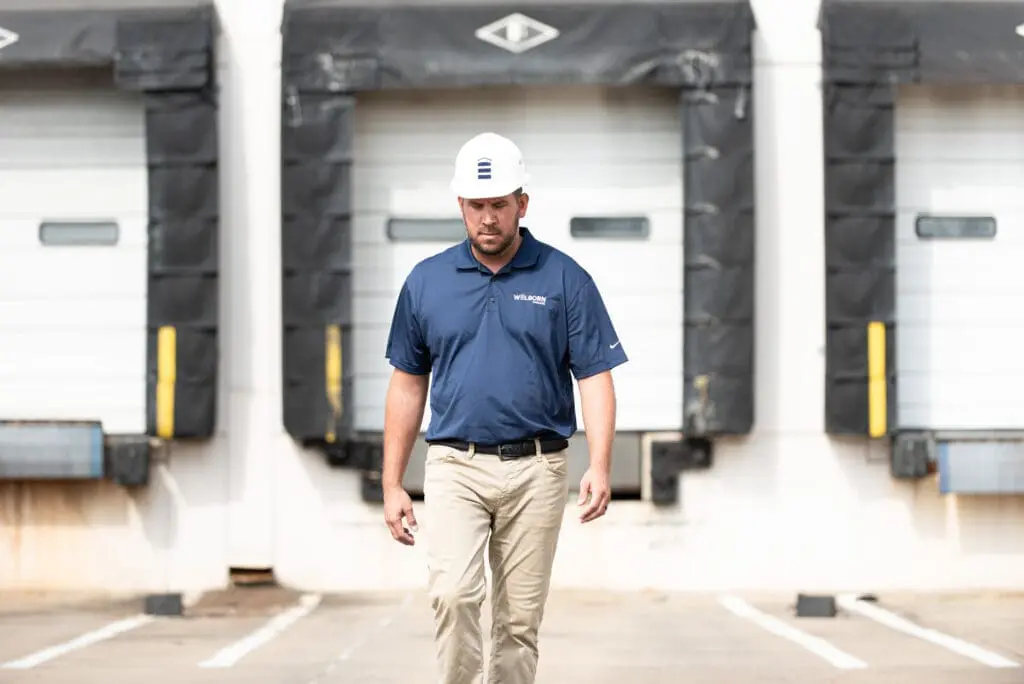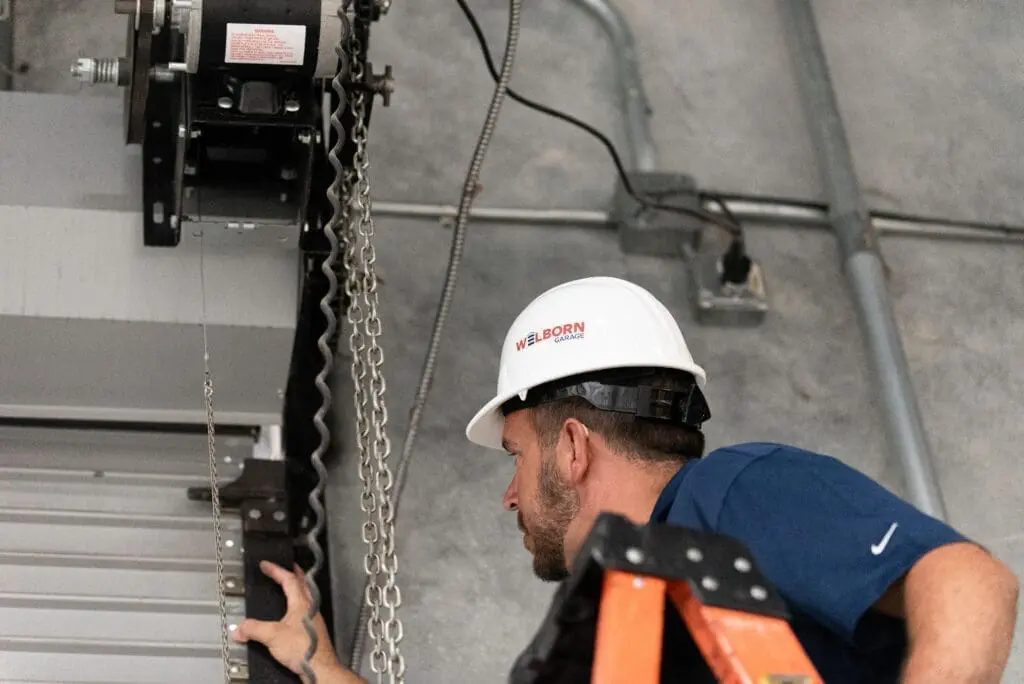Loading Dock Services In Dallas, TX
Get Same Day, Award Winning, 5- Star Garage Door Service
Loading Dock Services
In Dallas, TX
Get Same Day, Award Winning, 5- Star Garage Door Service
LOADING DOCK REPAIR
At Welborn, we understand the critical role that loading docks play in the smooth operation of your facility’s supply chain. A well-maintained loading dock ensures efficient loading and unloading operations, minimizes downtime, and enhances safety for workers and equipment. With years of experience and a team of skilled technicians, we specialize in diagnosing and addressing a wide range of loading dock issues promptly and effectively. Whether it’s repairing a malfunctioning dock leveler, replacing damaged dock seals, or fixing broken dock bumpers, we have the knowledge, expertise, and resources to get the job done right the first time.
LOADING
DOCK
REPAIR
At Welborn, we understand the critical role that loading docks play in the smooth operation of your facility’s supply chain. A well-maintained loading dock ensures efficient loading and unloading operations, minimizes downtime, and enhances safety for workers and equipment.
With years of experience and a team of skilled technicians, we specialize in diagnosing and addressing a wide range of loading dock issues promptly and effectively. Whether it’s repairing a malfunctioning dock leveler, replacing damaged dock seals, or fixing broken dock bumpers, we have the knowledge, expertise, and resources to get the job done right the first time.
EMERGENCY
REPAIR SERVICES
Unexpected breakdowns or malfunctions at your loading dock can cause major disruptions to your operations, leading to costly delays and safety hazards. That’s why we offer prompt and reliable emergency repair services to quickly address any loading dock issues and get your operations back up and running with minimal downtime.
Our team of experienced loading dock technicians is available 24/7 to respond to your emergency repair needs, no matter the time or day. Whether it’s a malfunctioning dock leveler, a damaged dock seal, or any other loading dock problem, we have the expertise and resources to diagnose and resolve the issue efficiently. With our rapid response times and fully equipped service vehicles, we can arrive onsite quickly to assess the situation and implement effective repairs to restore your loading dock to full functionality.

THE WELBORN GUARANTEE
Unmatched Warranty
We are so confident in the parts we use and labor we employ that we include a 1-year guarantee on parts and a 30-day guarantee on labor.
CONTACT US TODAY
DOCK LEVELERS
Dock levelers are mechanical devices used to bridge the gap between a loading dock and a truck or trailer bed, ensuring smooth and safe transfer of goods between the dock and the vehicle. They are a crucial component of loading dock equipment, particularly in facilities where trucks of varying heights arrive for loading and unloading.
They contain:
Adjustable Platform
Dock levelers consist of a platform that can be raised or lowered to match the height of the truck bed. This adjustable feature allows for seamless alignment between the dock and the vehicle, regardless of the height difference.
Hydraulic or Mechanical Operation
Dock levelers can be operated using either hydraulic or mechanical systems. Hydraulic dock levelers are powered by hydraulic cylinders, providing smooth and controlled movement of the platform. Mechanical dock levelers use springs or counterbalance mechanisms to raise and lower the platform manually.
Safety Features
Dock levelers are equipped with various safety features to prevent accidents and ensure worker safety. These may include lip extension barriers to prevent forklifts from driving off the edge, maintenance supports to secure the leveler during maintenance or servicing, and automatic safety locks to secure the leveler in place when not in use.
Durability and Load Capacity
Dock levelers are designed to withstand heavy loads and frequent use. They are typically constructed from durable materials such as steel and engineered to support the weight of loaded pallets, forklifts, and other equipment.
Lip Extension
Many dock levelers feature a lip that extends out from the edge of the platform to create a smooth transition between the dock and the truck bed. This lip helps prevent accidental bumps and gaps during loading and unloading.
Dock Shelters
and Seals
Dock shelters and seals come in various designs to accommodate different types of trucks and trailers, including inflatable seals, curtain-style shelters, and rigid frame shelters. They are typically made from durable materials such as vinyl, rubber, or fabric, and may be equipped with features such as adjustable curtains, compression pads, and side and top draft pads to ensure a tight seal. Proper installation and maintenance of dock shelters or seals are essential to maximize their effectiveness in protecting the loading dock area and maintaining indoor environmental quality.
Dock shelters or seals are structures designed to create a seal around the perimeter of a truck or trailer when it is backed into a loading dock. They serve several purposes, including:
Weather Protection
Dock shelters or seals help to create a barrier against inclement weather conditions such as rain, snow, wind, and extreme temperatures. By sealing the gap between the truck and the loading dock, they prevent drafts and minimize heat loss or gain, maintaining a more comfortable and consistent indoor environment.
Energy Efficiency
By minimizing the exchange of air between the interior of the facility and the exterior environment, dock shelters or seals contribute to improved energy efficiency. They help to reduce heating and cooling costs by preventing conditioned air from escaping and outside air from entering the building.
Dust and Pest Control
Dock shelters or seals also help to keep dust, debris, and pests from entering the facility during loading and unloading operations. This is particularly important in industries where cleanliness and sanitation are critical, such as food processing or pharmaceutical manufacturing.
Improved Worker
Comfort and Safety
By providing a more comfortable and controlled environment at the loading dock, dock shelters or seals enhance worker comfort and safety. They reduce exposure to harsh weather conditions, slippery surfaces, and airborne contaminants, helping to create a safer and more pleasant working environment for dock personnel.
Emergency
REPAIR SERVICE

Unexpected breakdowns or malfunctions at your loading dock can cause major disruptions to your operations, leading to costly delays and safety hazards. That’s why we offer prompt and reliable emergency repair services to quickly address any loading dock issues and get your operations back up and running with minimal downtime.
Our team of experienced loading dock technicians is available 24/7 to respond to your emergency repair needs, no matter the time or day. Whether it’s a malfunctioning dock leveler, a damaged dock seal, or any other loading dock problem, we have the expertise and resources to diagnose and resolve the issue efficiently. With our rapid response times and fully equipped service vehicles, we can arrive onsite quickly to assess the situation and implement effective repairs to restore your loading dock to full functionality.
THE WELBORN GUARANTEE

Unmatched Warranty
We are so confident in the parts we use and labor we employ that we include a 1-year guarantee on parts and a 30-day guarantee on labor
LOADING
DOCK
EQUIPMENT
Dock Levelers
Dock levelers are mechanical devices used to bridge the gap between a loading dock and a truck or trailer bed, ensuring smooth and safe transfer of goods between the dock and the vehicle. They are a crucial component of loading dock equipment, particularly in facilities where trucks of varying heights arrive for loading and unloading. They contain:
Adjustable Platform
Dock levelers consist of a platform that can be raised or lowered to match the height of the truck bed. This adjustable feature allows for seamless alignment between the dock and the vehicle, regardless of the height difference.
Hydraulic or Mechanical Operation
Dock levelers can be operated using either hydraulic or mechanical systems. Hydraulic dock levelers are powered by hydraulic cylinders, providing smooth and controlled movement of the platform. Mechanical dock levelers use springs or counterbalance mechanisms to raise and lower the platform manually.
Safety Features
Dock levelers are equipped with various safety features to prevent accidents and ensure worker safety. These may include lip extension barriers to prevent forklifts from driving off the edge, maintenance supports to secure the leveler during maintenance or servicing, and automatic safety locks to secure the leveler in place when not in use.
Durability and Load Capacity
Dock levelers are designed to withstand heavy loads and frequent use. They are typically constructed from durable materials such as steel and engineered to support the weight of loaded pallets, forklifts, and other equipment.
Lip Extension
Many dock levelers feature a lip that extends out from the edge of the platform to create a smooth transition between the dock and the truck bed. This lip helps prevent accidental bumps and gaps during loading and unloading.
Dock Shelters
and Seals
Dock shelters and seals come in various designs to accommodate different types of trucks and trailers, including inflatable seals, curtain-style shelters, and rigid frame shelters. They are typically made from durable materials such as vinyl, rubber, or fabric, and may be equipped with features such as adjustable curtains, compression pads, and side and top draft pads to ensure a tight seal. Proper installation and maintenance of dock shelters or seals are essential to maximize their effectiveness in protecting the loading dock area and maintaining indoor environmental quality.
Dock shelters or seals are structures designed to create a seal around the perimeter of a truck or trailer when it is backed into a loading dock. They serve several purposes, including:
Weather Protection
Dock shelters or seals help to create a barrier against inclement weather conditions such as rain, snow, wind, and extreme temperatures. By sealing the gap between the truck and the loading dock, they prevent drafts and minimize heat loss or gain, maintaining a more comfortable and consistent indoor environment.
Energy Efficiency
By minimizing the exchange of air between the interior of the facility and the exterior environment, dock shelters or seals contribute to improved energy efficiency. They help to reduce heating and cooling costs by preventing conditioned air from escaping and outside air from entering the building.
Dust and Pest Control
Dock shelters or seals also help to keep dust, debris, and pests from entering the facility during loading and unloading operations. This is particularly important in industries where cleanliness and sanitation are critical, such as food processing or pharmaceutical manufacturing.
Improved Worker Comfort and Safety
By providing a more comfortable and controlled environment at the loading dock, dock shelters or seals enhance worker comfort and safety. They reduce exposure to harsh weather conditions, slippery surfaces, and airborne contaminants, helping to create a safer and more pleasant working environment for dock personnel.
Dock Bumper
Dock bumpers are typically made from durable materials such as rubber, reinforced rubber, or polyurethane, which are capable of withstanding heavy loads and repeated impacts without deforming or deteriorating. They are available in various shapes and sizes to accommodate different types of loading docks and vehicles, and may be surface-mounted or recessed into the dock wall for a flush fit. Proper installation and maintenance of dock bumpers are essential to ensure their effectiveness in protecting both vehicles and loading dock infrastructure. Regular inspection and replacement of damaged or worn bumpers help to maintain a safe and functional loading dock environment.
Vehicle Protection
Dock bumpers protect the building structure and the trucks or trailers themselves from damage that can occur due to the repeated impact of vehicles backing into the loading dock. By absorbing the force of the impact, they help to prevent dents, scratches, and structural damage to both the vehicle and the building.
Dock Protection
In addition to protecting vehicles, dock bumpers also safeguard the loading dock itself. They help to prevent damage to the dock levelers, dock doors, and other equipment by absorbing the shock and vibration generated when trucks or trailers make contact with the dock during loading and unloading operations.
Safety Enhancement
Dock bumpers contribute to safety at the loading dock by reducing the risk of accidents and injuries. By providing a cushioned barrier between the vehicle and the loading dock, they help to minimize the likelihood of collisions, which can cause damage to property and equipment as well as pose a risk to personnel working in the area.
Worn or Missing Bumpers
Dock bumpers can become worn out or dislodged over time, especially if they are frequently impacted by trucks or trailers. Worn or missing bumpers compromise protection for both the vehicle and the loading dock infrastructure.
Improper Placement
Incorrect placement of dock bumpers can result in inadequate coverage of the dock wall, leaving vulnerable areas exposed to damage from vehicle impacts. Proper alignment and spacing of bumpers are essential for effective protection.
Inadequate Shock Absorption
Dock bumpers may lose their shock-absorbing properties over time, leading to increased transmission of impact forces to the building structure and the vehicles. This can cause damage and safety hazards during loading and unloading operations.
Common LOADING DOCK Problems
Several common problems can occur with loading docks, impacting their functionality and safety. These problems include:
DOCK LEVELERS
Hydraulic Fluid Leaks
One of the most common issues with hydraulic dock levelers is leaks in the hydraulic system. This can lead to reduced functionality, slow operation, or even complete failure of the leveler.
Platform Damage
Over time, the platform of dock levelers can suffer damage from heavy loads, impacts, or improper usage. Cracked or warped platforms can compromise safety and efficiency during loading and unloading operations.
Uneven or Stuck Operation
Dock levelers may become uneven or get stuck in a raised or lowered position, preventing smooth alignment with the truck bed. This can be caused by issues with the hydraulic system, mechanical components, or debris accumulation.
Worn or Damaged Components
Components such as lip hinges, springs, and hold-downs can wear out or become damaged with regular use. This can lead to instability, reduced load capacity, or unsafe conditions during operation.
DOCK SEALS & SHELTERS
Torn or Deteriorated Material
The fabric or rubber material used in dock seals and shelters can degrade over time due to exposure to weather, UV rays, and repeated contact with trucks. Torn or deteriorated material comprises the effectiveness of the seal, allowing drafts, pests, and debris to enter the facility.
Improper Installation
Incorrect installation of dock seals or shelters can result in gaps or inconsistencies that prevent a tight seal between the truck and the loading dock. This reduces energy efficiency, weather protection, and overall performance.
Damage from Truck Impact
Trucks backing into the loading dock can inadvertently damage dock seals or shelters, particularly if the driver misjudges the approach angle or speed. Impact damage can weaken the structure of the seal or shelter and lead to premature failure.
DOCK BUMPERS
Worn or Missing Bumpers
Trucks backing into the loading dock can inadvertently damage dock seals or shelters, particularly if the driver misjudges the approach angle or speed. Impact damage can weaken the structure of the seal or shelter and lead to premature failure.
Improper Placement
Incorrect placement of dock bumpers can result in inadequate coverage of the dock wall, leaving vulnerable areas exposed to damage from vehicle impacts. Proper alignment and spacing of bumpers are essential for effective protection.
Inadequate Shock Absorption
Dock bumpers may lose their shock-absorbing properties over time, leading to increased transmission of impact forces to the building structure and the vehicles. This can cause damage and safety hazards during loading and unloading operations.
CONTACT US TODAY
How does a malfunctioning loading dock door affect my business?
SAFETY
A properly functioning dock leveler eliminates uneven surfaces or gaps between the loading dock and the truck bed, reducing the risk of trips and falls for workers and equipment moving between the two. By providing a smooth transition, it minimizes manual handling requirements, allowing goods to be moved using material handling equipment such as forklifts or pallet jacks rather than relying on manual lifting. Dock levelers also ensure proper alignment between the loading dock and the truck or trailer, reducing the likelihood of vehicle accidents such as collisions with the dock or building structure. This stability also contributes to a safer working environment, preventing accidents like equipment tip-overs or collapses. By facilitating safe and efficient material handling, dock levelers help prevent accidents and injuries related to shifting loads or unstable surfaces.
SECURITY
Your dock leveler serves as a secure transition point between the facility interior and exterior, ensuring that loading and unloading activities occur only as intended and preventing unauthorized access to the premises. By facilitating efficient movement of goods between trucks and the facility, dock levelers help minimize the time inventory spends exposed at the loading dock, reducing the risk of theft or tampering. Some advanced dock leveler systems can integrate with facility security systems, enabling real-time monitoring and control of loading dock activities, which enhances security by providing alerts for unauthorized access attempts or suspicious activities. Efficient loading and unloading processes facilitated by properly functioning dock levelers minimize the opportunity for cargo theft by reducing the time that valuable goods are vulnerable while in transit.
SUPPLY CHAIN
By providing a smooth and stable transition between the loading dock and the truck bed, dock levelers streamline the loading and unloading process, reducing wait times and bottlenecks at the dock. Dock levelers also allow for precise alignment between the loading dock and the truck bed, maximizing space utilization within the truck during loading and unloading. This optimization helps minimize transportation costs and improve supply chain efficiency by maximizing the quantity of goods transported in each shipment. Properly functioning dock levelers also reduce the risk of damage to goods by ensuring secure and stable loading conditions, thereby maintaining product quality and integrity throughout the supply chain.
DOCK BUMPERS
Dock bumpers are typically made from durable materials such as rubber, reinforced rubber, or polyurethane, which are capable of withstanding heavy loads and repeated impacts without deforming or deteriorating. They are available in various shapes and sizes to accommodate different types of loading docks and vehicles, and may be surface-mounted or recessed into the dock wall for a flush fit. Proper installation and maintenance of dock bumpers are essential to ensure their effectiveness in protecting both vehicles and loading dock infrastructure. Regular inspection and replacement of damaged or worn bumpers help to maintain a safe and functional loading dock environment.
Dock bumpers are protective devices installed on the exterior walls of loading docks to absorb the impact of trucks or trailers as they back into the loading bay. They serve several important functions:
Vehicle Protection
Dock bumpers protect the building structure and the trucks or trailers themselves from damage that can occur due to the repeated impact of vehicles backing into the loading dock. By absorbing the force of the impact, they help to prevent dents, scratches, and structural damage to both the vehicle and the building.
Dock Protection
In addition to protecting vehicles, dock bumpers also safeguard the loading dock itself. They help to prevent damage to the dock levelers, dock doors, and other equipment by absorbing the shock and vibration generated when trucks or trailers make contact with the dock during loading and unloading operations.
Durability and Load Capacity
Dock levelers are designed to withstand heavy loads and frequent use. They are typically constructed from durable materials such as steel and engineered to support the weight of loaded pallets, forklifts, and other equipment.
Safety Enhancement
Dock bumpers contribute to safety at the loading dock by reducing the risk of accidents and injuries. By providing a cushioned barrier between the vehicle and the loading dock, they help to minimize the likelihood of collisions, which can cause damage to property and equipment as well as pose a risk to personnel working in the area.
Worn or Missing Bumpers
Dock bumpers can become worn out or dislodged over time, especially if they are frequently impacted by trucks or trailers. Worn or missing bumpers compromise protection for both the vehicle and the loading dock infrastructure.
Improper Placement
Incorrect placement of dock bumpers can result in inadequate coverage of the dock wall, leaving vulnerable areas exposed to damage from vehicle impacts. Proper alignment and spacing of bumpers are essential for effective protection.
Inadequate Shock Absorption
Dock bumpers may lose their shock-absorbing properties over time, leading to increased transmission of impact forces to the building structure and the vehicles. This can cause damage and safety hazards during loading and unloading operations.
Common LOADING DOCK Problems
Several common problems can occur with loading docks, impacting their functionality and safety. These problems include:
DOCK LEVELERS
Hydraulic Fluid Leaks
One of the most common issues with hydraulic dock levelers is leaks in the hydraulic system. This can lead to reduced functionality, slow operation, or even complete failure of the leveler.
Platform Damage
Over time, the platform of dock levelers can suffer damage from heavy loads, impacts, or improper usage. Cracked or warped platforms can compromise safety and efficiency during loading and unloading operations.
Uneven or Stuck Operation
Dock levelers may become uneven or get stuck in a raised or lowered position, preventing smooth alignment with the truck bed. This can be caused by issues with the hydraulic system, mechanical components, or debris accumulation.
Worn or Damaged Components
Components such as lip hinges, springs, and hold-downs can wear out or become damaged with regular use. This can lead to instability, reduced load capacity, or unsafe conditions during operation.
DOCK SEALS & SHELTERS
Torn or Deteriorated Material
The fabric or rubber material used in dock seals and shelters can degrade over time due to exposure to weather, UV rays, and repeated contact with trucks. Torn or deteriorated material comprises the effectiveness of the seal, allowing drafts, pests, and debris to enter the facility.
Improper Installation
Incorrect installation of dock seals or shelters can result in gaps or inconsistencies that prevent a tight seal between the truck and the loading dock. This reduces energy efficiency, weather protection, and overall performance.
Damage from Truck Impact
Trucks backing into the loading dock can inadvertently damage dock seals or shelters, particularly if the driver misjudges the approach angle or speed. Impact damage can weaken the structure of the seal or shelter and lead to premature failure.
DOCK BUMPERS
Worn or Missing Bumpers
Dock bumpers can become worn out or dislodged over time, especially if they are frequently impacted by trucks or trailers. Worn or missing bumpers compromise protection for both the vehicle and the loading dock infrastructure.
Improper Placement
Incorrect placement of dock bumpers can result in inadequate coverage of the dock wall, leaving vulnerable areas exposed to damage from vehicle impacts. Proper alignment and spacing of bumpers are essential for effective protection.
Inadequate Shock Absorption
Dock bumpers may lose their shock-absorbing properties over time, leading to increased transmission of impact forces to the building structure and the vehicles. This can cause damage and safety hazards during loading and unloading operations.
CONTACT US TODAY
How does a malfunctioning LOADING DOCK
door affect my business?
SAFETY
A properly functioning dock leveler eliminates uneven surfaces or gaps between the loading dock and the truck bed, reducing the risk of trips and falls for workers and equipment moving between the two. By providing a smooth transition, it minimizes manual handling requirements, allowing goods to be moved using material handling equipment such as forklifts or pallet jacks rather than relying on manual lifting.
Dock levelers also ensure proper alignment between the loading dock and the truck or trailer, reducing the likelihood of vehicle accidents such as collisions with the dock or building structure. This stability also contributes to a safer working environment, preventing accidents like equipment tip-overs or collapses. By facilitating safe and efficient material handling, dock levelers help prevent accidents and injuries related to shifting loads or unstable surfaces.
SECURITY
Your dock leveler serves as a secure transition point between the facility interior and exterior, ensuring that loading and unloading activities occur only as intended and preventing unauthorized access to the premises. By facilitating efficient movement of goods between trucks and the facility, dock levelers help minimize the time inventory spends exposed at the loading dock, reducing the risk of theft or tampering. Some advanced dock leveler systems can integrate with facility security systems, enabling real-time monitoring and control of loading dock activities, which enhances security by providing alerts for unauthorized access attempts or suspicious activities.
Efficient loading and unloading processes facilitated by properly functioning dock levelers minimize the opportunity for cargo theft by reducing the time that valuable goods are vulnerable while in transit.
SUPPLY CHAIN
A loading dock door malfunction can lead to delays in receiving or dispatching goods, disrupting production schedules, inventory levels, and customer orders. This delay can ripple through the supply chain, affecting various stages of the process. The reduced efficiency resulting from a malfunctioning garage door can lead to longer wait times for trucks to load or unload, increasing idle time and reducing overall productivity. These inefficiencies can result in additional costs for the company, including overtime pay for employees, expedited shipping fees, or penalties for missed delivery schedules. Inventory management may also be affected, leading to excess inventory buildup or stockouts, impacting product availability and customer satisfaction.
CONTACT US TODAY
PREVENTATIVE
MAINTENANCE
Preventative maintenance is crucial for loading dock garage doors to prevent breakdowns, ensure safety, extend lifespan, maintain efficiency, comply with regulations, and preserve security. By conducting routine inspections, lubricating moving parts, and tightening loose components, businesses can prevent unexpected breakdowns and reduce downtime.
CONTACT US TODAY
preventative
MAINTENANCE

Preventative maintenance for a loading dock is a comprehensive process aimed at ensuring the reliability, safety, and efficiency of all equipment and infrastructure. This entails regular inspections, cleaning, lubrication, and repair of various components such as dock levelers, seals, bumpers, doors, and safety features. Scheduled inspections help identify signs of wear, damage, or malfunction, while cleaning and lubrication prevent friction, corrosion, and premature deterioration. Additionally, testing and calibration of equipment, along with prompt repair or replacement of damaged parts, ensure that the loading dock operates smoothly and accurately. Safety checks are crucial to verify the functionality of safety features, promoting compliance with regulations and standards.
The importance of preventative maintenance lies in its ability to maximize equipment lifespan, minimize downtime, and enhance safety. By addressing potential issues proactively, maintenance efforts extend the longevity of loading dock equipment, reducing the need for costly repairs or replacements. This, in turn, minimizes downtime caused by equipment breakdowns or malfunctions, ensuring that loading dock operations can proceed smoothly and efficiently.


